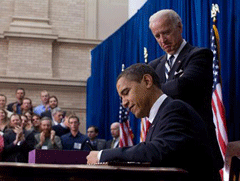Green Report Card
Air Date: Week of May 1, 2009

President Obama signing the American Recovery and Reinvestment Act, directing nearly $80 billion to clean energy, the environment and science. (Photo by Pete Souza, Courtesy of the White House)
The Obama administration has hit the ground running on clean energy, climate change and other environmental matters. Living on Earth reviews the administration's major acts. And we'll hear from the president's top environmental advisor, Nancy Sutley.
Transcript
YOUNG: The auto industry’s just one area where President Obama has tried to steer energy, the environment and the economy together during his first hundred days in office. To get an idea of what’s happened in those hundred days, consider just one day: Monday, April 27th:
On that day, the Environmental Protection Agency indicated it will toughen rules on pollution from power plants. The Interior Department reversed rules that let mountaintop removal coal mines dump waste near streams. And Obama’s Secretary of State said the US was ready to lead the way to a global warming agreement.
All in just one day--and a Monday at that.
This president who stressed “the fierce urgency of now” on the campaign trail has wasted no time. His first major legislative achievement, the economic stimulus package, put tens of billions of dollars toward clean energy. Obama told workers at an Iowa wind turbine facility that he’s made more progress in three months than the country has seen in three decades.
OBAMA: We're beginning to break the bonds, the grip, that fossil fuels has on us. We're beginning to create a new, clean-energy economy -- and the millions of jobs that will flow from it.
CURWOOD: President Obama assembled an environmental team that has won high praise from the scientific community. And Team Obama has overturned Bush-era decisions on energy, endangered species and land management. President Obama’s Interior Secretary, Ken Salazar, put the Republican plan for offshore drilling on hold and revoked some controversial drilling permits.
SALAZAR: We revisited the decision to offer areas in Utah near Arches and Canyonland National Parks for oil and gas drilling and I’m proud of that decision.
YOUNG: But despite this early burst of activity, there are still doubts about whether the course the administration is setting will meet the tremendous challenges.
I sat down with Nancy Sutley to talk about that. As chair of the White House Council on Environmental Quality, she’s the president’s top environmental policy adviser. Sutley says she’s pleased with the administration’s early progress.

Nancy Sutley.
YOUNG: Let’s talk about the clean energy investment and the green jobs creation. Is it mostly the potential for green jobs creation or is the stimulus money actually getting out quickly enough were you have concrete examples you can point to – here are green jobs.
SUTLEY: Well, I think there’s a broad spectrum of things that come under green jobs, but the American Recovery and Reinvestment Act really does have money going out the door quickly to fund some programs that we know work, things like low income weatherization, things like investing in research and development for things like smart grid that’s already going out the door. Those investments are green jobs.
YOUNG: On climate change, I gotta say, here we are 100 days and you haven’t solved global warming yet.
SUTLEY: Well, yeah, give us a few more days, but you know – I think we’ve made a lot of progress. The Recover Act gives us a good template to work from and those funds, you know, really is to grow this sector of the economy, but also to really address the peril that global warming is putting our planet into. The U.S. was sort of missing in action for the last eight years, so things like the President showing leadership at the international level, the State Department is hosting this major economies forum, it’s a way to get to the largest economies of the world who also happen to be the largest greenhouse gas emitters talking to each other in anticipation of Copenhagen. So there’s been a lot going on in climate change.

President Obama signs the stimulus bill into law, directing nearly $80 billion to clean energy, the environment and science. (Photo by Pete Souza, the White House)
SUTLEY: I think the American people are hopeful and optimistic about the ability to run our economy more sustainably, to create millions of jobs that can’t be exported overseas. We’re running the risk of falling behind on things like manufacturing renewable energy products and so I think there’s a sense of hopefulness that this new green economy and that this investment in clean energy will produce real benefits for the American economy, and I think people understand that.
YOUNG: That’s Nancy Sutley, chair of the White House Council on Environmental Quality. You can hear the entire interview at our website, loe.org.
[MUSIC: Bill Laswell “Beyond The Zero” from Dub Chamber 3 (Universal Songs Of Polygram Intl 2000)]
CURWOOD: A warming planet, two wars and a weak economy—this president has his hands full. And now we add to that list the threat of pandemic flu. Just ahead, we explore the possible links between the flu virus and factory farming.
Keep listening to Living on Earth.
Links
Hear all of Jeff Young’s interview with Nancy Sutley.
… our profile of Lisa Jackson….
... our profile of Labor Secretary Hilda Solis….
… our analysis of the President’s science team …
And our story on Secretary of State Hilary Clinton visit to China
Living on Earth wants to hear from you!
Living on Earth
62 Calef Highway, Suite 212
Lee, NH 03861
Telephone: 617-287-4121
E-mail: comments@loe.org
Newsletter [Click here]
Donate to Living on Earth!
Living on Earth is an independent media program and relies entirely on contributions from listeners and institutions supporting public service. Please donate now to preserve an independent environmental voice.
NewsletterLiving on Earth offers a weekly delivery of the show's rundown to your mailbox. Sign up for our newsletter today!
 Sailors For The Sea: Be the change you want to sea.
Sailors For The Sea: Be the change you want to sea.
 The Grantham Foundation for the Protection of the Environment: Committed to protecting and improving the health of the global environment.
The Grantham Foundation for the Protection of the Environment: Committed to protecting and improving the health of the global environment.
 Contribute to Living on Earth and receive, as our gift to you, an archival print of one of Mark Seth Lender's extraordinary wildlife photographs. Follow the link to see Mark's current collection of photographs.
Contribute to Living on Earth and receive, as our gift to you, an archival print of one of Mark Seth Lender's extraordinary wildlife photographs. Follow the link to see Mark's current collection of photographs.
 Buy a signed copy of Mark Seth Lender's book Smeagull the Seagull & support Living on Earth
Buy a signed copy of Mark Seth Lender's book Smeagull the Seagull & support Living on Earth

